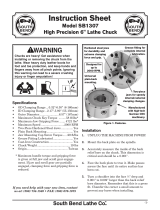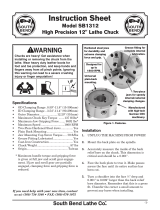
-8-
Model M1099 (Mfg Since 8/07)
SAFETY
Additional Safety Instructions for Lathes
CLEARING CHIPS. Metal chips can easily cut bare
skin—even through a piece of cloth. Avoid clear-
ing chips by hand or with a rag. Use a brush or
vacuum to clear metal chips.
CHUCK KEY SAFETY. A chuck key left in the
chuck can become a deadly projectile when the
spindle is started. Always remove the chuck key
after using it. Develop a habit of not taking your
hand off of a chuck key unless it is away from
the chuck.
TOOL SELECTION. Cutting with an incorrect or dull
tool bit will often overload the bit and cause it
to dig into the workpiece and snap. As a result,
hot razor-sharp shards may be ejected that can
result in a burn or blinding injury. To increase
safety, decrease tool bit load, and provide the
best nish possible, always use the correct tool
and one that is sharp.
SPEED RATES. Operating the lathe at the wrong
speed can cause nearby parts to break or the
workpiece to come loose, which will result in
dangerous projectiles that could cause severe
impact injury. Large workpieces must be turned
at slow speeds. Always use the appropriate feed
and speed rates.
STOPPING SPINDLE BY HAND. Stopping the spin-
dle by putting your hand on the workpiece or
chuck creates an extreme risk of entanglement,
impact, crushing, friction, or cutting hazards.
Never attempt to slow or stop the lathe spindle
with your hand. Allow the spindle to come to a
stop on its own or use the brake (if equipped).
LONG STOCK SAFETY. Long stock can whip vio-
lently if not properly supported, causing serious
impact injury and damage to the lathe. Reduce
this risk by supporting any stock that extends
from the chuck/headstock more than three
times its own diameter. Always turn long stock
at slow speeds.
SAFE CLEARANCES. Workpieces that crash into
other components on the lathe may throw dan-
gerous projectiles in all directions, leading to
impact injury and damaged equipment. Before
starting the spindle, make sure the workpiece
has adequate clearance by hand-rotating it
through its entire range of motion. Also, check
the tool and tool post clearance, chuck clear-
ance, and saddle clearance.
REMOVING/INSTALLING CHUCKS. Chucks are
heavy and often oily and slippery to hold. Losing
your grip on a chuck can lead to crushed hands
or amputated fingers. To reduce this risk and
protect the lathe bed, cover the bed with a
sheet of wood and use a chuck cradle. For large
chucks, also get the assistance of one or more
people, and use an appropriate hoisting appara-
tus when installing or removing.
SECURING WORKPIECE. A thrown workpiece may
cause severe injury or even death. When swap-
ping the chuck jaw positions, double-check that
the jaw fasteners are tight and that the top jaw
is fully seated with the lower jaw no gaps exist
between the two. When clamping a workpiece,
maximum gripping force is attained at full jaw
and scroll gear engagement. If jaw and scroll
gear are only partially engaged, clamping force
is reduced.
CRASHES. Tooling or components that contact a
spinning chuck may shatter sending metal frag-
ments in all directions resulting in severe impact
injuries and major damage to the lathe. Reduce
this risk by releasing automatic feeds after use
and checking clearances before starting the
lathe.
CUTTING FLUID SAFETY. Contaminated cutting
fluid is a toxic biohazard that can cause poison-
ing from skin contact. Incorrectly positioned
cutting fluid nozzles can splash on the operator
or the floor, resulting in an exposure or slipping
hazard. To decrease your risk, change cutting
fluid regularly and use the system carefully.






















